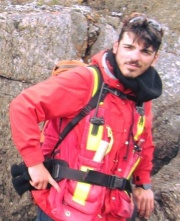Jacob VanderWal
vanderwal

BSc (Honours)
B.Sc. (Honours) Thesis
CALCITE FRACTURE-FILLING: A PROXY FOR GEOTHERMAL ENERGY SYSTEMS, AND IMPLICATIONS FOR THE TECTONIC HISTORY OF THE NORTHEASTERN MIDLAND VALLEY, SCOTLAND
(PDF - 52.3 Mb)
Geothermal energy has emerged as a reliable, cost-effective, and sustainable energy resource in areas of tectonic activity where hot sub-surface fluid circulation is common. Precipitation of carbonates within fractures that act as fluid conduits can act to modify and reduce flow, acting as a limiting factor to geothermal energy production. It is therefore important to understand the relationship between mineral precipitation, fluid source, and precipitation temperatures when assessing the economic potential of a geothermal locality. Here we present optical and cathodoluminescence (CL) petrography, δ13C and δ18O stable isotope data, minor and trace element analyses, UPb dating, and clumped isotope temperature calculations for six carbonate veins collected from a ‘fossil’ analogue (easily accessible) basalt-hosted (Montrose Volcanic) geothermal system in Lunan Bay Scotland, part of the Midland Valley Terrane. Calcite growth is observed as stretched and bladed crystals likely formed during active fracturing, and blocky, altered crystals indicative of post-fracture precipitation. CL signatures (suggestive of changes in minor element concentrations Fe2+ and Mn2+) exhibit relatively constant signatures across most veins and amygdales, disconnected from fluctuations seen in Fe2+ and Mn2+ concentrations as well as d13C and d18O values. U-Pb calcite vein ages suggest Mid Devonian to Mid Carboniferous vein precipitation, while clumped isotope paleothermometry gives vein precipitation temperatures between 120 and 190 oC for vein samples, and 70 oC for amygdales. These temperatures are out of equilibrium with calcites expected to have precipitated from meteoric fluids within ambient bedrock temperatures and are therefore likely to have a magmatic-meteoric magmatic fluid-source, as is supported by back-calculated d18O calculations. Complex bedrock buffering of the fluids is also suggested, supported by the minor and isotopic variations mentioned above, as well as LREE enriched, chondrite normalized REE trends. The findings of this study have implications towards the age of Montrose Volcanic formation deposition (younger than previously suggested), and suggest that prolonged, subsurface igneous activity no longer observed within the rock record continued within the northern Midland Valley Terrane into the Carboniferous. Furthermore, the methodologies applied within this study (primarily U-Pb dating in conjunction with clumped isotope paleothermometry) show potential to accurately date and determine the temperature of calcite scaling within active geothermal systems, providing insights into the economic potential of a geothermal locality.
Keywords: calcite veining, fracture-filling, clumped isotope paleothermometry, stable isotopes, U-Pb dating, geothermal energy, Scotland, Midland Valley
Pages: 79
Supervisor: John MacDonald



